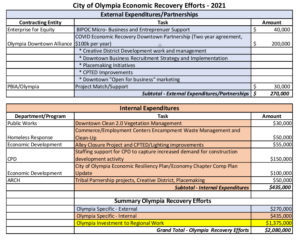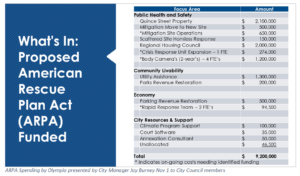A substantial infusion of money—is anyone counting?
Soon after Biden took office, Congress passed the American Rescue Plan Act (ARP Rescue Plan). Thurston County jurisdictions will share a windfall of over $82 million in “fiscal recovery funds.” Half the money came this May and the rest will come next May. It all has to be obligated by the end of 2024 and spent by the end of 2025.

The Treasury Department has published initial rules for spending the money, but it’s not possible to know exactly what expenditures are eligible until the final rule comes out. While each jurisdiction has already made decisions about the use of funds, they might have to be adjusted later.
Who’s deciding how to spend the money
Officials here have made little effort to include the public in deciding how to allocate the money. This runs counter to the Rescue Plan’s directive to address systemic challenges that contribute to unequal outcomes of the pandemic. The directive indicates that enlisting meaningful participation from the community—including underserved members who are often excluded from civic life—is essential to the best use of the funds.
The task of ensuring that ARP funds are deployed in a way that isn’t wasteful—doesn’t duplicate efforts or overlap other funding—has also been neglected. A Thurston County report on ARP notes that “It has been difficult to plan the best use of these funds when we don’t know what the state or neighbor jurisdictions are investing in. “
Finally, the fiscal recovery fund is a one-time injection of money that shouldn’t create obligations for future budgets. As one analyst noted, the funds should be “transformative,” instead of adding money for existing structures and programs.
A lot of money has been allocated already
Elected officials in all jurisdictions have identified uses for some of the money, but none have publicized their decisions. Olympia and Tumwater have approved allocations for the total amount of the funds. Officials in Thurston County and Lacey are still in the process of evaluating some possibilities.
Thurston County—$56.4 million
Details of the County’s process and proposals for use of the ARP funds are in an August 31 report that is available online. (1) The report includes ideas for using $45 million still unallocated.
According to the report, the County will invite community comment on these ideas via survey and outreach through partner organizations, program providers and social media, “to ensure feedback from traditionally underserved populations, including people of color, people with low income and populations with limited English proficiency. “
So far, Commissioners have approved allocation of $11 million of their total, to be distributed as follows: business including minority (51%), intern job hires (14%), nonprofits including youth support (14%), agricultural markets (9%), basic needs (8), public health (3%). [See the sidebar on page 10 for specific amounts.]
The report points out that the County will spend more than $100 million in pandemic-related funds from federal programs and other sources. For context, the County points out that its annual budget is $110 million.
Lacey $11.45 million
At an April 23 retreat Lacey City Council members decided to focus use of ARP funds on increasing the number of permanent supportive housing units available to the homeless population. The idea had been presented and discussed at an earlier work session and a joint meeting with Thurston County Commissioners. Some documents indicate that Lacey has also committed $1.3 million to a regional pot of money to be administered by the Thurston Economic Development Council (EDC).
After the retreat, Lacey Mayor Andy Ryder suggested to the members of the Regional Housing Council (RHC) that the three cities and the County work together to leverage ARP funds for a major project on housing. The purpose would be to achieve the goal of the Homeless Crisis Response Plan that had been developed with broad participation in 2019: to make homelessness “rare and infrequent” by 2024. RHC members agreed to seek funding to obtain 150-200 of the 300 supportive housing units called for in the Crisis Response Plan.
Lacey received $2.3 million in funds from the CARES Act in 2020. Lacey adopted a budget for 2022 that is below their 2021 budget.
Olympia—$9.2 million*
Olympia has taken a staff-led, top-down approach to deciding how to use its ARP funds. Staff conversations produced an “Economic Recovery Plan” that was presented by the City Manager and approved by Council members at their May 4 meeting. That plan covered a total of only $2.08 million and listed items ranging from downtown and homeless camp clean-up to support for the Downtown Alliance and minority-owned businesses and revenue recovery. $1.375 million was shown as regional investment via the EDC. An amendment by Councilman Cooper to reserve $2 million related to the regional housing effort brought the total to $4.08 million.
On Nov. 1, City Manager Burney presented a proposal that covered Olympia’s full $9.2 million: $6.6 million related to homelessness (purchase of the Quince St. Mitigation site plus operating costs) and $2 million for regional housing, $1.2 million for body cameras, $1.3 million to clear overdue utility bills, $700,000 to recover lost city revenues. Despite the Act’s emphasis on one-time only enhancements and a deepening revenue shortfall projected for future Olympia budgets, at least seven of the proposed expenditures are for new FTEs.
In 2020, the City of Olympia received $2.4 million through the CARES Act. The city is currently considering raising taxes on some city services along with a 2022 budget higher than the current budget.
Tumwater—$2.5 million
Tumwater’s decision as to use of the ARP funds is tied to the city’s Strategic Plan and Goals and reflects results from Tumwater’s most recent Community Summit. Mayor Pete Kmet and City Administrator John Doan presented a conceptual plan for allocating the funds at a work session with Council members.
At a subsequent meeting (September 7, 2021), Tumwater Council members discussed the pros and cons of different possible options for spending the ARP money (each member’s statements are summarized in the minutes posted online). They decided on a plan that included items ranging from donating a house to Homes First ($400,000), funding local and indigenous artists, renovation of the Brewtower, recovering utility debt ($50,000), $550,000 for the regional housing project; a two-year position to oversee economic development, and $350,000 to the EDC.
Tumwater’s adopted (biennial) budget for 2021-22 is less than the preceding biennial budget. This reporter was unable to identify CARES funds that went to Tumwater.
Yelm—$2.6 million
At their October 26, 2021 meeting, Yelm City Council Members discussed and adopted a recommendation by City Manager Michael Grayum to use about half of their ARP funds as follows: 1) pay off the City’s investment in a 640-acre property that is part of a Local Improvement District slated for future development;
2) purchase body cameras for Yelm police officers; 3) recover the City’s investment in remote technology acquired for use during the pandemic. This amounted to about $1.2 million, with the remainder available for uses to be identified in the next three years.
Thurston Economic Development Council— Many millions of dollars
The Thurston Economic Development Council is a “public private” entity, created by state law as and reporting to the Dept. of Commerce. The EDC, operating through “Thurston Strong” has been the program and grant administrator for millions of dollars in federal funds aimed to alleviate local impacts of the pandemic. This reporter was not able to find information about how the EDC administers the funds or decides on eligibility criteria for awarding grants.
How to follow the money?
It isn’t easy to pin down the use of the cash that has flowed into the county during the pandemic. Who decided, how they decided, where exactly the money went—and will go—remains to be discovered. But with these taxpayer dollars we should expect inclusion, transparency and accountability.
(1) Thurston County, Washington Recovery Plan, discoverable online under that name.
*Some documents including the minutes of the May 4 meeting say that Olympia’s ARP allocation is $10.06
Initial arp funding decisions—Thurston CountyIn a report dated August 31, 2021, Thurston County set out their approach to using American Rescue Plan funds. The report identifies decisions made already, along with programs and projects that are under consideration. The latter include such things as broadband, access to affordable housing, repair of small local water and sewer systems, expanding access to government, a safer environment at the county corrections facility, providing resources to clear court backlogs and replacing lost revenue. Over the next eight months the county “will refine the plan for funding allocation and track the effectiveness of the programs funded.” The three County Commissioners as of Aug 31 had approved funding for proposals listed below. This shows the amount allocated. You can read an explanation for each expenditure plus the other possibilities by searching online for: Thurston County Washington, State and Local Fiscal Recovery Plan, 2022. Public Health
Negative Economic Impacts
Services to disproportionately impacted
|


Be First to Comment